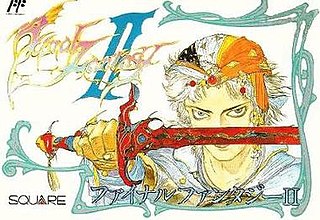
Final Fantasy II is a fantasy role-playing video game developed and published by Square in 1988 for the Family Computer as the second installment of the Final Fantasy series. The game has received numerous enhanced remakes for the WonderSwan Color, the PlayStation, the Game Boy Advance, the PlayStation Portable, PC and multiple mobile and smartphone types. As neither this game nor Final Fantasy III were initially released outside Japan, Final Fantasy IV was originally released in North America as Final Fantasy II, so as not to confuse players. Following enhanced versions for iOS and Android in 2010 and 2012 respectively, the game was rereleased again as part of the 2021 Final Fantasy Pixel Remaster series.

Doom II, also known as Doom II: Hell on Earth, is a first-person shooter game by id Software. It was released for MS-DOS computers in 1994 and Macintosh computers in 1995. Unlike the original Doom, which was initially only available through shareware and mail order, Doom II was sold in stores.

Painkiller is a first-person shooter video game developed by Polish game studio People Can Fly and published by DreamCatcher Interactive in 2004. The game's single player campaign follows a dead man in Purgatory who is offered a deal to defeat the invading forces of Lucifer's army in exchange for being allowed to enter Heaven. The game was particularly well-received for its multiplayer experience and was featured for two seasons on the Cyberathlete Professional League's World Tour.

Disgaea: Hour of Darkness is a tactical role-playing video game developed and published by Nippon Ichi Software for the Sony PlayStation 2 video game console.
Warlords is a video game series created by Steve Fawkner, in which role-playing elements are combined with turn-based strategy in a fantasy setting. The series includes four games and two expansion packs. Several remakes exist.

Paper Mario: The Thousand-Year Door is a 2004 role-playing video game developed by Intelligent Systems and published by Nintendo for the GameCube. The Thousand-Year Door is the second game in the Paper Mario series following Paper Mario, and is part of the larger Mario franchise. In the game, when Mario and Princess Peach get involved in the search for a mystic portal that holds great fortune, Peach is kidnapped by an alien group called the X-Nauts; Mario sets out to find the treasure and save the princess.

Langrisser is a fantasy tactical role-playing video game series created by Masaya Games. The main development team is Career Soft, first as Team Career within Masaya Games for the first three games and then as an independent studio for Langrisser IV and V. The series has a fantasy-Germanic setting, but draws on religious concepts like ditheism and sword worship for historical context. The series was originally released for Sega platforms during the 1990's, with the first two installments originally made for the Mega Drive, followed by third through fifth installments for the Sega Saturn. Ports and remakes were also made for other platforms such as PC Engine, Super Famicom, PC-FX and PlayStation during the same period.

Shining Force II is a tactical role-playing game for the Mega Drive/Genesis console developed by Sonic! Software Planning in 1993. Its storyline is not directly connected to the original Shining Force, although a Game Gear title Shining Force Gaiden: Final Conflict links the two games' plots.
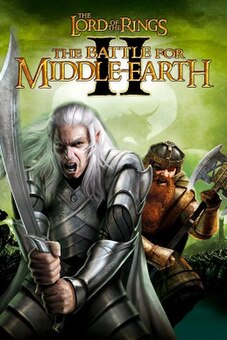
The Lord of the Rings: The Battle for Middle-earth II is a 2006 real-time strategy video game developed and published by Electronic Arts. It is based on the fantasy novels The Lord of the Rings and The Hobbit by J. R. R. Tolkien and its live-action film series adaptation. It is the sequel to Electronic Arts' 2004 title The Lord of the Rings: The Battle for Middle-earth. Along with the standard edition, a Collector's Edition of the game was released, containing bonus material and a documentary about the game's development.

God of War II is an action-adventure game developed by Santa Monica Studio and published by Sony Computer Entertainment (SCE). First released for the PlayStation 2 console on March 13, 2007, it is the second installment in the God of War series, the sixth chronologically, and the sequel to 2005's God of War. The game is based on Greek mythology and set in ancient Greece, with vengeance as its central motif. The player character is protagonist Kratos, the new God of War who killed the former, Ares. Kratos is betrayed by Zeus, the King of the Olympian Gods, who strips him of his godhood and kills him. Slowly dragged to the Underworld, he is saved by the Titan Gaia, who instructs him to find the Sisters of Fate, as they can allow him to travel back in time, avert his betrayal, and take revenge on Zeus.

Age of Empires: The Age of Kings is a turn-based strategy video game developed by Backbone Entertainment and published by Majesco Entertainment for the Nintendo DS handheld video game console.
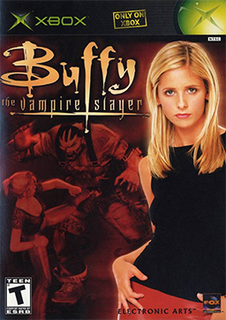
Buffy the Vampire Slayer is an action beat 'em up video game addition to the Buffy the Vampire Slayer franchise. It is the second video game of the franchise to be released, though the earliest in terms of setting and the first for a console. The novella and dialogue of the game were written by Christopher Golden and Thomas Sniegoski, with additional dialogue provided by Richard Hare.
Deep Dungeon (ディープダンジョン) is a series of role-playing video games developed by HummingBirdSoft. The first two installments were released on the Family Computer Disk System by Square's label DOG; the third one was released on the regular Family Computer by Square directly and the final one by Asmik.
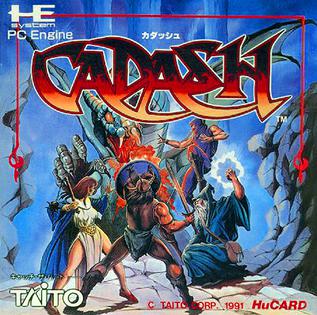
Cadash is an action-adventure video game which combines elements of the platformer and role-playing video game genres. The game was originally an arcade game released by Taito in 1989, later ported to home video game consoles such as the TurboGrafx-16 in 1991 and the Sega Mega Drive/Genesis in 1992. The game was included in Taito Memories Volume 2 which was released for the PlayStation 2 in 2005. It was also included in the Xbox and PC versions of Taito Legends 2 which was released in 2007.

Might and Magic Mobile is an action-adventure video game developed by Gameloft Beijing and published by Gameloft. It was released for keypad-based mobile phones on October 19, 2004 and for the Nintendo DSi on February 1, 2010.

Ys II: Ancient Ys Vanished – The Final Chapter is an action role-playing video game developed by Nihon Falcom, and first released on June 24, 1988 for the PC-8801 and PC-9801. It is the sequel to Ys I: Ancient Ys Vanished, and takes place immediately following the end of the first game. The game has received a very large number of ports and remakes over the years.

Heroes of Might and Magic V: Tribes of the East is the second expansion pack to the turn-based strategy game Heroes of Might and Magic V and the first stand-alone expansion pack released for the fifth series. It was developed by Nival Interactive and was released by Ubisoft on October 12, 2007 in Europe and on October 25 in North America and Russia.

The Godfather II is a 2009 action-adventure game developed by EA Redwood Shores and published by Electronic Arts. It was released for Microsoft Windows, PlayStation 3, and Xbox 360 in April. Based on the 1974 film The Godfather Part II, it is the sequel to the 2006 game The Godfather, which was based on the 1972 film of the same name. Like the first game, The Godfather II follows a non-canon character, Dominic, who is initially the protégé and underboss of the original game's protagonist, Aldo Trapani. After Aldo is killed, Dominic is placed in charge of the Corleone family's operations in New York City and tasked with expanding the Corleone empire by taking out their rivals. Unlike the first game, which was primarily set in New York, the story also spans into Miami and Havana.

Risen 3: Titan Lords is an action role-playing game developed by Piranha Bytes and published by Deep Silver. It is the sequel to Risen 2: Dark Waters and the third installment in the Risen series. The Enhanced Edition of the game was released on 21 August 2015 worldwide for the PlayStation 4. It is also provided as a free upgrade for PC players who own the game and all its DLC on Steam.
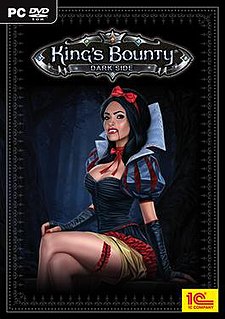
King's Bounty: Dark Side is a 2014 strategy video game developed for Microsoft Windows by 1C-Softclub and published by 1C Company. The game was released on August 14, 2014. It is a standalone installment in the King's Bounty series.



















